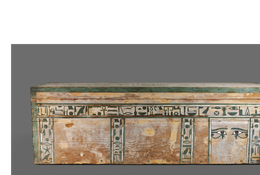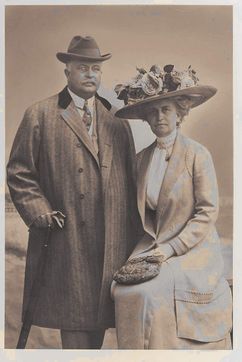Mummies in Ohio (5)
|
Cleveland (1)
Senbi The tale of Senbi's mummy, if that really is his name, is an exemplar of the confusion which reigns in the field of mummy identification. The casual visitor to the Cleveland Museum of Art might happen upon, if it happened to be on view, an austere wooden oblong box adorned with bands of beautiful blue hieroglyphs. The museum card would identify this coffin as dating to the mid-12th Dynasty and having belonged to "the king's letter scribe, Senbi." Our hypothetical visitor might wonder whether Senbi were still inside and might go so far as to ask a nearby guard if this was indeed the case. One can only guess at the possible answers our modern-day Herodotus might receive, but only one would be correct. Senbi, the scribe of royal documents during the reign of Amenemhat II or Sesostris III, or at least the mummy that occupied this box when it reached Cleveland in 1914 is not inside. He is, in fact, currently in a sub-collection of the Hamann-Todd Osteological Collection called the Hamann-Todd Decimal Collection, in the Cleveland Museum of Natural History. Neither he, described as a "mummy, head and postcranial skeleton" or his fellow countrymen now consisting of three other disembodied heads and three hands are on public view. The story of Senbi
In 1910 a small tomb was excavated at the site of ancient Meir. It was just large enough to hold 3 rectangular coffins from the 12th Dynasty made for three different men who shared the same name, Senbi, as reported by Ahmed Bey Kamal in: Rapport sur les fouilles executees dans la zone comprise entre Deirout au nord et Deir-el-Ganadlah, au sud," Annales du Service des antiquités de l'Egypte 12 (1912): 120-21. One of these coffins happened to be purchased in Asyut in 1913 by Henry W. Kent (Met Secretary American Wing) acting for the tragic historian of Sienese art, Lucy Olcott Perkins. In A Passion for Egypt: Arthur Weigall, Tutankhamun and the 'Curse of the Pharaohs' Julie Hankey shares Weigall's description of an excavation overseen by Kamal: |
"A native named Said Bey obtained a permit to excavate from our Department ... Ahmed Bey Kamal, an old Egyptian employee at the Museum, half blind and not having a rudimentary knowledge of scientific methods, was told to go and look after him. Magnificent antiquities were found, and Ahmed Bey was allowed to make the division himself with Said Bey who was to sell his half (the other half going to the Museum), which at least put a grave temptation in the way of both men to make a deal with the balance on the side of the originator of the scheme. Said Bey's share of the spoil was sold for hundereds of pounds. One statue alone fetched £300. No record was made of the work, but as a sop to the archaeologtists a brief catalogue of the antiquities was drawn up -- of no use to anybody. this really scandalous piece of work was authorized by our Director General..." Everything about this story is chance. Chance that the tomb was discovered in 1910 during the murky excavations of Ahmed Bey Kamal, chance that The John Huntington Trust had donated $100,000 to create the core collections of the Cleveland Art Museum. And that the first $25,000 was designated for the acquisition of Egyptian Art. Chance that the buyer would be Lucy Olcott Perkins, chance that JP Morgan had fallen ill and sailed on to Rome to die, stranding Lythgoe without any funds.
An amazing story worth further investigation. |
|
Columbus (1)
Ohio Historical Society Ohio History Center at 800 E 17th Ave. (Exit 111 off Highway I-71), Columbus, Ohio, 43211 Amunet Egyptologist Cynthia May Sheikholeslami's lecture about Amunet April 18, 2013: https://youtu.be/koZ3mQDJmXQ Scanning: https://www.ohiohistory.org/learn/collections/archaeology/amunet-ct-scan-project The coffin: https://www.ohiohistory.org/learn/collections/archaeology/amunet-ct-scan-project/the-coffin |
COSI
333 W Broad St, Columbus, OH 43215 COSI (The Center of Science and Industry) The Franklin County Historical Society has a traveling exhibit of artifacts on loan from the Brooklyn Museum and The Academy of Natural Sciences that feature a mummy called Annie: Lost Egypt Dayton (1)
Boonshoft Museum of Discovery (1) 2600 DeWeese Parkway Dayton, OH 45414 937.275.7431 J. Morton Howell collected many objects during his tenure as Minister to Egypt in the 1920's. Several mummies, one in Columbus at the Ohio History Center and another Nesiur. She was in the Dayton Public Library Museum, and now is in the Egyptian section of the Explorers Exhibit at the Boonshoft Museum. |
|
Toledo (2)
Toledo Museum of Art 2445 Monroe St, Toledo, OH 43620 (419) 255-8000 toledomuseum.org The Toledo Museum of Art has two mummies both males, one from 800 BCE, the other from the Roman period. They were collected in 1906 by museum founders Edward and Florence Libby, and are rarely on view because of conservation issues. However, if you are reading this before May 6, 2018 you are in luck! They have not been out since 2010, but they are currently part of a special exhibition: The Mummies: From Egypt to Toledo in the Canady Gallery ran until May 6 2018. Story about the exhibition in the Toledo Blade. |


